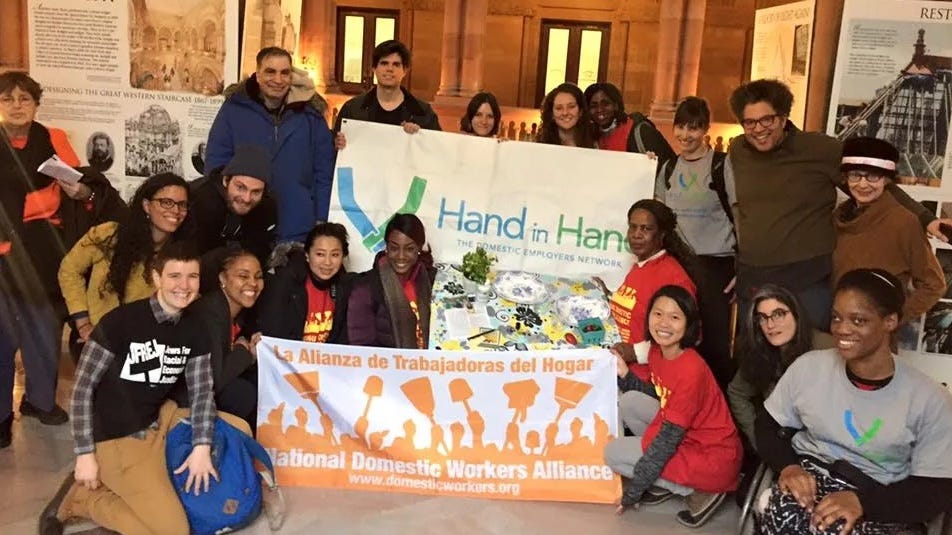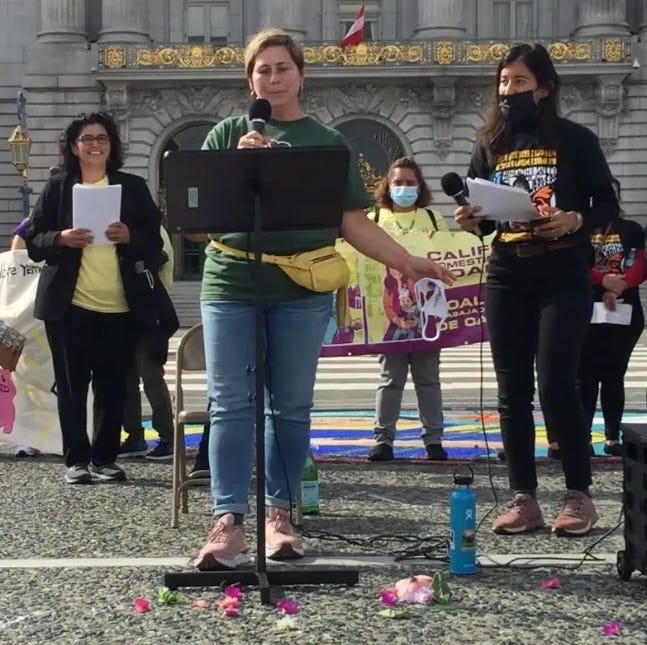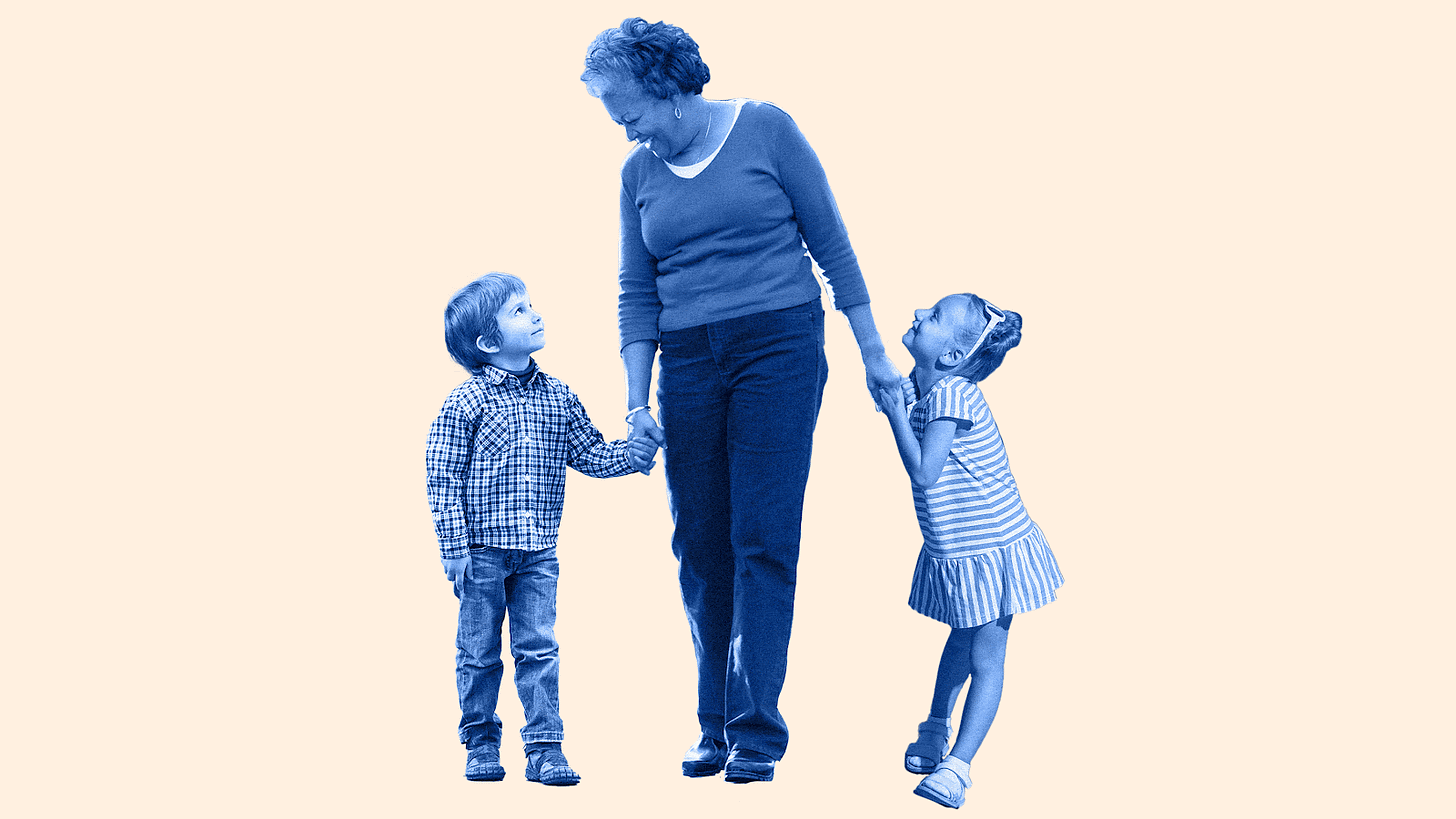"You’re the employer. Don’t let them use you!"
Interview with Stacy Kono and Erica Sklar from Hand in Hand

Hand in Hand: The Domestic Employers Network is one of the most compelling current-day experiments in cross-class solidarity that I know of. It’s also a badass, feminist, women-led organizing project that I want to celebrate and help get some shine.
As a national organization of employers of nannies, house cleaners and home attendants, it advocates for domestic worker rights. It was born out of, and remains nested within, the larger domestic worker movement.
I first learned about Hand in Hand, from Danielle Feris in 2010. Danielle was their founding Executive Director and a trusted colleague through my work at Resource Generation (RG).
I’ve stayed connected to Hand in Hand ever since, and am delighted to have interviewed their current Executive Director, Stacy Kono and their Lead National Organizer, Erica Sklar in October of 2023. As usual, the interview has been edited for content and clarity.
MG: How do you think about the class components of your organizing?
SK: Hand in Hand’s work is rooted in cross-class organizing. It grew out of the campaign to win the New York State Domestic Worker Bill of Rights, which at the time was led by Jews for Racial and Economic Justice (JFREJ). A significant part of JFREJ’s base were people who employed nannies and house cleaners. These employers wanted to practice the Jewish value of “Shalom Bayit,” or peace in the home, by joining the growing domestic worker movement. JFREJ organizer Danielle Feris and Ai-jen Poo [Current President of the National Domestic Workers Alliance] saw their impact and founded Hand in Hand in 2010.

In Hand in Hand’s approach to organizing, class matters. We need people with class privilege to recognize their responsibility to domestic workers, to pay them fairly and provide basic rights and benefits. It's essential that employers understand the role they can play in transforming the domestic work industry and confronting the oppressions that have led to the devaluation of this work.
Not all domestic employers are owning class - in fact far from it. Our base includes so many; middle class people who employ house cleaners, parents in nanny shares, older adults who need help in the home, and low-income people with disabilities whose attendant support is funded by Medicare.
Many of our members know what it’s like to have their care work be devalued. The disregard that our society has placed on care, is something that people across class lines feel in their families and communities.
MG: What is a challenge you’ve faced in organizing employers?
SK: For many reasons, the biggest initial roadblock is often that people resist the idea they even are an employer.
There can be feelings of shame and embarrassment that get in the way. Sometimes people are embarrassed to admit that they get support with care or cleaning. Others feel shame because they don’t want to be seen as the “boss” of a domestic worker.
It's a process for them to see that they have the same responsibilities to provide fair pay and benefits as all other employers do.
MG: Your comments about the challenges of people claiming their identity as employers reminds me of the challenges of getting wealthy people to claim their identity as rich people. There is so much more power when people go towards and own these identities that they might see as oppressive or ‘bad’.
ES: Yes! I think Hand in Hand has become a political home for many people who maybe resist the identifier of “domestic employer” at first and then realize “Oh, actually, this is a place where there's a potential for a lot of impact through that identity.” Legislators want to use employers as a scapegoat, as the reason not to pass laws protecting domestic workers. We don’t let them get away with that. We tell people, “You're the employer. Don’t let them use you. You have to go tell them what the legislation means to you and not let them put words in your mouth.”
Two years ago, our National Domestic Workers Bill of Rights had its first hearing in a subcommittee of the Labor Committee at the House of Representatives. It was an incredible moment and the result of over 15 years of organizing, winning 13 state-level policies and 4 municipal laws.
Former Representative Fred Keller, from Pennsylvania’s 12th District, and his colleagues argued against the bill, claiming that creating protections for domestic workers would only harm employers, forcing them into bankruptcy from legal fees and damages.
It takes strong voices to rebut that fear-based messaging.
MG: Tell me more about your work specifically with professional middle class and wealthy employers.
ES: The reality is that the voices of our wealthy members are important to winning legislative fights.
For example, in Washington DC in 2022, we passed a domestic worker bill of rights at the City Council. Our bill champion was a city council member who was very pro-labor. Our very first meeting with her, she told us, “I need you to get me employers from ward three in Washington, D.C. [the really wealthy district] who are going to be with me and have my back on this.” We organized several wealthier nanny and house cleaner employers to voice their support. It made a difference and we passed the bill!
SK: In addition to legislative wins, middle and owning class people have the power to change the narrative on our relationship to domestic workers. Last year, we worked with one of our members, Reha Sterbin, in New York City to write a really great article in Marie Claire magazine. It’s called My Silence Makes Her Invisible: Parents Must Fight for Nannies and Domestic Workers.
It's awesome! Reha writes as a professional who wants the workers who are caring for her kids to have the same dignity, respect and protections that she has as a software engineer and consultant.
Reha is one of many professional middle class members who became activated during the last eight years since Trump was elected.
During this COVID era, a whole set of people joined us out of a newly found consciousness about the importance of domestic work. The child care crisis and home care crisis around the country has affected so many people from all sorts of backgrounds. It really crossed class lines.
ES: I want to underline that point Stacy just made. In the hardest moments of the pandemic, we really felt the need from employers, across class, for a reliable continuum of care. Employers who depend on home healthcare workers were afraid for their lives. Parents who relied on schools and nannies and childcare workers were in an impossible situation, trying to work and take care of their kids. So many experienced how important domestic workers are.

Our members often notice how the issues we work on are about more than just class and money.
I remember one of our members saying, “Everyone on this call is a woman. 90% of domestic workers are women. This is a women's issue. So women can work. Me, and also them.”
The reality of the domestic worker movement is that it stands at many intersections. I think this is a benefit to our organizing–because if you are a person who's really interested in fighting against ableism or sexism or racism or for immigrant rights, the domestic worker movement is a critical part of all of those struggles. Even the climate crisis is related to domestic work because domestic worker jobs are green jobs - that are local and contribute to care over consumption. They need to be family sustaining jobs. Care affects everyone.
MG: Tell me more about your base. Who counts as a member and how active are the wealthier members of your base?
SK: We have about 500 members right now.1 Some of those folks are giving a dollar a month and organizing their friends to join, and some are making major gifts of over $100,000 and speaking out at rallies.
You know Gretchen and Jim Sandler? Gretchen and Jim are examples of people with wealth who have supported domestic workers and immigrant communities in their philanthropy, while also speaking out as employers.
Gretchen's been awesome. She has spoken at rallies to talk about being a house cleaner employer who supports paid sick leave. She went to Sacramento to support health and safety protections for domestic workers. She shares her story with the media. She and Jim have been major donors to Hand in Hand and domestic worker organizations for many, many years and hosted events to invite their friends to support and join our efforts.

Our wealthy members generally aren't yet as active in our campaigns as the low income and middle class members, but we know they have a powerful role to play!
MG: Are there particular ways you move the more class privileged parts of your base?
SK: Across the board we’ve learned that it’s important that our relationships with employers lead with openness and empathy. In a lot of our movements, shame can be a powerful motivator - “you are bad unless you do this.” That’s not what we do.
We point to the often overlooked history of exclusion that left Black domestic workers without labor rights during the New Deal. We talk with our members about the devaluation of work in the home, denigrated as informal and unprofessional “women’s work”. This exclusion and erasure has left domestic employers without formal guidance and with informal practices that are still tied to this racist history and misogynist culture. For example, when the pandemic started, and households began to isolate, many people did not think about the impact of letting go workers who don’t have access to unemployment and other basic benefits and rights.
One important tool we use, in our large group and 1:1 meetings, is to ask people to share their personal story of being an employer of a domestic worker. Why does domestic worker rights matter to them? What difference have domestic workers made in their lives? Through answering these questions, our members get clearer about their shared stake in the success of the domestic worker movement. Their personal story is a powerful organizing tool they can use to recruit new members, lobby elected officials, and with the media.
I really loved the interview you did with Rajasvini and how she encouraged people with wealth to be agents of change, even as we acknowledge that the voices that most seriously need to be amplified are those of working class communities of color.
That vision, of full agency and accountability, is what we aspire to at Hand in Hand.
MG: What’s a mistake that you’ve made in your cross-class organizing that you want others to learn from?
SK: As we were building our base beyond nanny and house cleaner employers, low and middle income attendant employers [mostly disabled] challenged us to more fully acknowledge the importance of affordability. We listened and realized we needed to change.
Affordability is a huge issue, it can mean the difference between independent living vs institutionalization for people with disabilities, and many elders. We shifted our work to demand public investment in care alongside respect for domestic and care workers.
MG: What’s the lineage of this type of cross-class, mutual interest, organizing?
SK: We've got a lot of allies in groups like Showing Up for Racial Justice (SURJ) and National Domestic Workers Alliance (NDWA). Senior and Disability Action as well as other disability justice groups have also been really important because, like us, they share a deep commitment to social and racial justice, as well as disability access and visibility.
In terms of lineage, I can think of a few important examples.
Many years before I started at Hand in Hand, one of the first campaigns I worked on was the Garment Workers Justice campaign, a boycott of a multimillion dollar dress manufacturer, Jessica McClintock. I remember Asian Immigrant Women Advocates organized consumers with a similar call for solidarity, really pushing the message that, “You as consumers who buy fancy Jessica McClintock dresses have a role to play in supporting the workers that actually sew these clothes”.
Hand in Hand also follows in the footsteps of the United Farm Workers (UFW) and the way they engaged people across class, as consumers, in solidarity with their struggle for justice and dignity in the fields. They created a movement that brought in ordinary people and celebrities while still centering the voices of workers.
Both these campaigns sought to move the broader community, including many middle class and wealthy people, out of the charitable mindset of “I want to help those poor workers”, to a solidarity framework, toward a vision of multiracial, caring communities. This is our goal too, and we build off the efforts and lessons of garment worker and farm worker movements.
Lastly, I want to say that the women’s movement has a long history of cross-class, multi-racial solidarity. Our friends at NDWA built this amazing timeline of domestic worker organizing. It includes information about a Domestic Workers conference in 1938, hosted by the Chicago Domestic Workers Association (CDWA) and the Women’s Trade Union League (WTUL). The focus of the event was to introduce a bill in the state legislature that would have brought domestic workers under the provision of the 8-hour work day law and establish a minimum wage.While the CDWA’s membership was all domestic workers, mostly Black with a handful of white immigrants, the Women’s Trade Union League included both working-class women and upper-class “allies” who supported the organization financially. Sound familiar?! One of the key leaders of the Chicago chapter of the WTUL was Margaret Dreier Robins, an upper-class woman who devoted her life to the organization.
So much of what we’re up to parallels efforts in our recent past. So many of the challenges and questions we face are similar to ones from generations before. I’m both reassured and inspired to know we have an incredible set of ancestors at our back, to learn from and be motivated by.
How do we get more people to a place of solidarity in action? I don't have all the answers and I am proud of the shifts we are seeing because of our work.

Thank you Stacy and Erica!
What lessons are you taking from Hand in Hand’s organizing?
What questions are you left with?
I’d love to hear from you! Like this post, leave a comment below, and share with others.
Hand in Hand defines membership as somebody who's made a contribution and taken more than two actions with them in the last year. Every year they invite people to renew their membership. They are not a formal membership organization.





